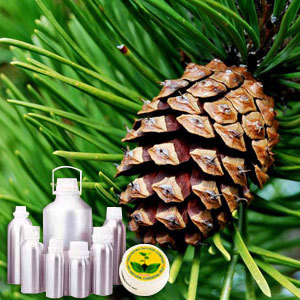Botonical Name | : | Pinus sylvestris | |
CAS # | : | 8002-09-3 | |
Country of Origin | : | Hungary | |
Color & Odor | : | Colourless to pale yellow liquid with woody, evergreen odor | |
Solubility | : | Insoluble in water, soluble in alcohol and oils | |
Specific Gravity | : | 0.86000 – 0.89000 @ 25 °C | |
Optical Rotation | : | -5° to -10° | |
Refractive Index | : | 1.480 - 1.485 @ 25 °C | |
Flash Point | : | 65 °C | |
Major Constituents | : | a-pinene, d-limonene, b-pinene | |
Plant Part Used | : | Needles and Twigs | |
Extraction Method | : | Steam Distillation |
DESCRIPTION:
Reddish brown colored pine trees have maximum 40 meters of height. The pointed grayish green colored leaves of these trees emerge in pairs and these are accompanied by conical brown fruits and yellowish orange flowers. CONSTITUENTS:
Pine Oil contains elements like Cineol, Citral, Chamazulene and Bornyl Acetate. This oil is also enriched with Monoterpene hydrocarbons that include Ocimene, Myrcene, Sabinene, Carene, Camphene, Dipentene, Pinenes and Terpinenes. AROMATIC SUMMARY / NOTE / STRENGTH OF AROMA:
Top note powerful fragrance of Pine oil has distinctive scent which is reminiscence of forest. BLENDS WITH:
Pine essential oil is compatible with other essential oils like Frankincense, Clary sage, Myrrh, Rosemary, Eucalyptus, Coriander, Lavender, Tea tree, Juniper, Cypress, Spikenard and Citronella. COMMON NAMES:
This fragrant essential oil is commonly referred as Pine oil. USES:
Pine Oil is effective in curing health complications like bladder circulation difficulty, arthritis, nerve related problems, kidney failure, mental tiredness, rheumatism, fatigue, respiratory problems, gout, muscle ache and influenza. As an effective fragrant, Pine oil is used in cosmetics. 


































